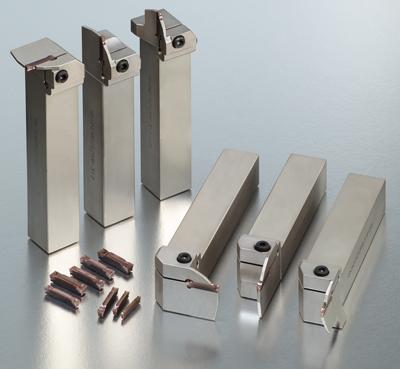
New GND grooving tool holders from Sumitomo Electric Carbide Inc. are engineered to reduced chatter and eliminate vibration. Featuring high rigidity bodies and single-piece special steel construction, the GND reportedly produces less chatter and eliminates vibration.
GND tool holders also deliver steady performance for turning, profiling, facing and cut-off applications. Due to precision sintering technology, the GND tool inserts offer improved tolerance of +/-0.0012" (+/-0.03mm) for all grooving widths from 0.079" to 0.250" (2.0 to 6.0mm).
GND tool holders also provide special chipbreakers for various machining applications. Each of the six chipbreakers serves a specific purpose from turning to profiling to facing. The GND lineup features the following chipbreakers: MG, a general feed type for turning, ML, a low feed type for multi-purpose use, GG, a general feed type for grooving, GL, a low feed type for grooving, CG, a general feed type for cut-off, and RG a general feed type for profiling.
Contact Details
Related Glossary Terms
- chatter
chatter
Condition of vibration involving the machine, workpiece and cutting tool. Once this condition arises, it is often self-sustaining until the problem is corrected. Chatter can be identified when lines or grooves appear at regular intervals in the workpiece. These lines or grooves are caused by the teeth of the cutter as they vibrate in and out of the workpiece and their spacing depends on the frequency of vibration.
- feed
feed
Rate of change of position of the tool as a whole, relative to the workpiece while cutting.
- grooving
grooving
Machining grooves and shallow channels. Example: grooving ball-bearing raceways. Typically performed by tools that are capable of light cuts at high feed rates. Imparts high-quality finish.
- profiling
profiling
Machining vertical edges of workpieces having irregular contours; normally performed with an endmill in a vertical spindle on a milling machine or with a profiler, following a pattern. See mill, milling machine.
- sintering
sintering
Bonding of adjacent surfaces in a mass of particles by molecular or atomic attraction on heating at high temperatures below the melting temperature of any constituent in the material. Sintering strengthens and increases the density of a powder mass and recrystallizes powder metals.
- tolerance
tolerance
Minimum and maximum amount a workpiece dimension is allowed to vary from a set standard and still be acceptable.
- turning
turning
Workpiece is held in a chuck, mounted on a face plate or secured between centers and rotated while a cutting tool, normally a single-point tool, is fed into it along its periphery or across its end or face. Takes the form of straight turning (cutting along the periphery of the workpiece); taper turning (creating a taper); step turning (turning different-size diameters on the same work); chamfering (beveling an edge or shoulder); facing (cutting on an end); turning threads (usually external but can be internal); roughing (high-volume metal removal); and finishing (final light cuts). Performed on lathes, turning centers, chucking machines, automatic screw machines and similar machines.






